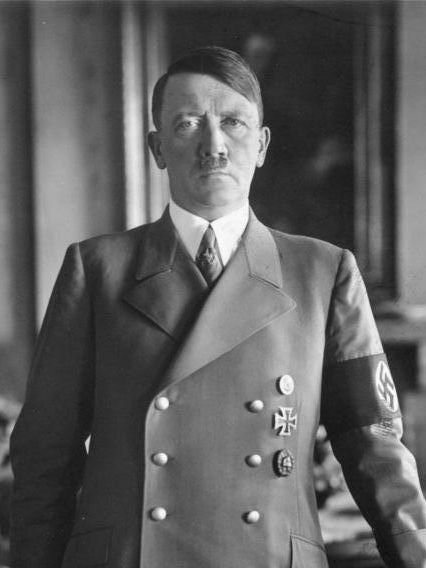
Main Facts
Adolf Hitler (20 April 1889 – 30 April 1945) was a German politician who was the leader of the Nazi Party, Chancellor of Germany from 1933 to 1945, and Führer ("Leader") of Nazi Germany from 1934 to 1945. As dictator, he initiated World War II in Europe with the invasion of Poland in September 1939, and was central to the Holocaust.
Hitler was born in Austria, then part of Austria-Hungary, and raised near Linz. He moved to Germany in 1913 and was decorated during his service in the German Army in World War I.
Under Hitler's leadership and racially motivated ideology, the Nazi regime was responsible for the genocide of at least 5.5 million Jews and millions of other victims whom he and his followers deemed Untermenschen (sub-humans) and socially undesirable. Hitler and the Nazi regime were also responsible for the killing of an estimated 19.3 million civilians and prisoners of war.
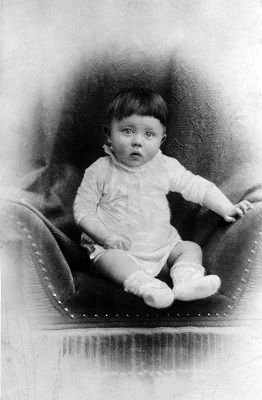
Childhood
He was the fourth of six children born to Alois Hitler (1837–1903) and Klara Pölzl (1860–1907). Three of Hitler's siblings—Gustav, Ida, and Otto—died in infancy. When Hitler was three, the family moved to Passau, Germany. There he acquired the distinctive lower Bavarian dialect, rather than Austrian German, which marked his speech throughout his life
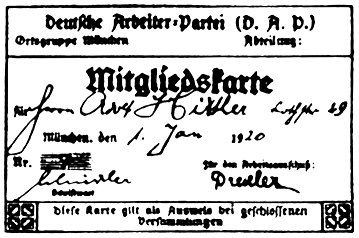
Entry into Politics
After World War I, Hitler returned to Munich. Without formal education or career prospects, he remained in the army. Impressed with Hitler's oratorical skills, Hitler was invited to join the DAP. Hitler accepted on 12 September 1919, becoming party member 555 (the party began counting membership at 500 to give the impression they were a much larger party).
At the DAP, Hitler met Dietrich Eckart, one of the party's founders and a member of the occult Thule Society. Eckart became Hitler's mentor, exchanging ideas with him and introducing him to a wide range of Munich society. Hitler designed the party's banner of a swastika in a white circle on a red background.
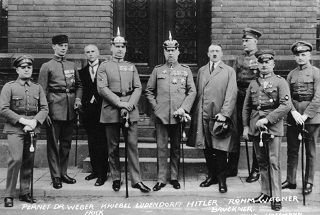
Beer Hall Putsch
In 1923 Hitler enlisted the help of World War I General Erich Ludendorff for an attempted coup known as the "Beer Hall Putsch". The NSDAP used Italian Fascism as a model for their appearance and policies. Hitler wanted to emulate Benito Mussolini's "March on Rome" of 1922 by staging his own coup in Bavaria, to be followed by a challenge to the government in Berlin. Hitler and Ludendorff sought the support of Staatskommissar (state commissioner) Gustav Ritter von Kahr, Bavaria's de facto ruler. However, Kahr, along with Police Chief Hans Ritter von Seisser and Reichswehr General Otto von Lossow, wanted to install a nationalist dictatorship without Hitler.
Shortly before Hitler was eligible for parole, the Bavarian government attempted to have him deported back to Austria. The Austrian federal chancellor rejected the request on the specious grounds that his service in the German Army made his Austrian citizenship void. In response, Hitler formally renounced his Austrian citizenship on 7 April 1925.
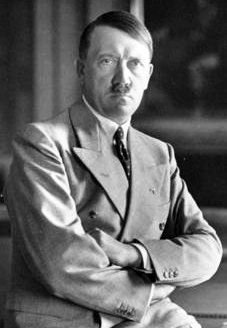
Dictatorship
Having achieved full control over the legislative and executive branches of government, Hitler and his allies began to suppress the remaining opposition. The Social Democratic Party was banned and its assets seized. While many trade union delegates were in Berlin for May Day activities, SA stormtroopers demolished union offices around the country. On 2 May 1933 all trade unions were forced to dissolve and their leaders were arrested. Some were sent to concentration camps. The German Labour Front was formed as an umbrella organisation to represent all workers, administrators, and company owners, thus reflecting the concept of national socialism in the spirit of Hitler's Volksgemeinschaft ("people's community").
By the end of June, the other parties had been intimidated into disbanding. This included the Nazis' nominal coalition partner, the DNVP; with the SA's help, Hitler forced its leader, Hugenberg, to resign on 29 June. On 14 July 1933, the NSDAP was declared the only legal political party in Germany.
Hitler took care to give his dictatorship the appearance of legality. Many of his decrees were explicitly based on the Reichstag Fire Decree and hence on Article 48 of the Weimar Constitution. The Reichstag renewed the Enabling Act twice, each time for a four-year period. While elections to the Reichstag were still held (in 1933, 1936, and 1938), voters were presented with a single list of Nazis and pro-Nazi "guests" which carried with well over 90 percent of the vote. These elections were held in far-from-secret conditions; the Nazis threatened severe reprisals against anyone who didn't vote or dared to vote no.
Start of World War II
In private discussions in 1939, Hitler declared Britain the main enemy to be defeated and that Poland's obliteration was a necessary prelude for that goal. On 3 April, Hitler ordered the military to prepare for Fall Weiss ("Case White"), the plan for invading Poland on 25 August. In a Reichstag speech on 28 April, he renounced both the Anglo-German Naval Agreement and the German–Polish Non-Aggression Pact. Historians such as William Carr, Gerhard Weinberg, and Kershaw have argued that one reason for Hitler's rush to war was his fear of an early death. He had repeatedly claimed that he must lead Germany into war before he got too old, as his successors might lack his strength of will.
Hitler was concerned that a military attack against Poland could result in a premature war with Britain. Hitler's foreign minister and former Ambassador to London, Joachim von Ribbentrop, assured him that neither Britain nor France would honour their commitments to Poland. Accordingly, on 22 August 1939 Hitler ordered a military mobilisation against Poland.
On 1 September 1939, Germany invaded western Poland under the pretext of having been denied claims to the Free City of Danzig and the right to extraterritorial roads across the Polish Corridor, which Germany had ceded under the Versailles Treaty. In response, Britain and France declared war on Germany on 3 September, surprising Hitler and prompting him to angrily ask Ribbentrop, "Now what?" France and Britain did not act on their declarations immediately, and on 17 September, Soviet forces invaded eastern Poland.

Path to defeat
On 22 June 1941, contravening the Hitler–Stalin Non-Aggression Pact of 1939, 4–5 million Axis troops attacked the Soviet Union. This offensive (codenamed Operation Barbarossa) was intended to destroy the Soviet Union and seize its natural resources for subsequent aggression against the Western powers. The invasion conquered a huge area, including the Baltic republics, Belarus, and West Ukraine. By early August, Axis troops had advanced 500 km (310 mi) and won the Battle of Smolensk. Hitler ordered Army Group Centre to temporarily halt its advance to Moscow and divert its Panzer groups to aid in the encirclement of Leningrad and Kiev. His generals disagreed with this change, having advanced within 400 km (250 mi) of Moscow, and his decision caused a crisis among the military leadership. The pause provided the Red Army with an opportunity to mobilise fresh reserves; historian Russel Stolfi considers it to be one of the major factors that caused the failure of the Moscow offensive, which was resumed in October 1941 and ended disastrously in December
On 7 December 1941, Japan attacked the American fleet based at Pearl Harbor, Hawaii. Four days later, Hitler declared war against the United States.
In December 1942 and January 1943, Hitler's repeated refusal to allow their withdrawal at the Battle of Stalingrad led to the almost total destruction of the 6th Army. Over 200,000 Axis soldiers were killed and 235,000 were taken prisoner. Thereafter came a decisive strategic defeat at the Battle of Kursk. Hitler's military judgement became increasingly erratic, and Germany's military and economic position deteriorated, as did Hitler's health

Defeat and Death
By late 1944, both the Red Army and the Western Allies were advancing into Germany. Recognising the strength and determination of the Red Army, Hitler decided to use his remaining mobile reserves against the American and British troops, which he perceived as far weaker. On 16 December, he launched the Ardennes Offensive to incite disunity among the Western Allies and perhaps convince them to join his fight against the Soviets. The offensive failed after some temporary successes. With much of Germany in ruins in January 1945, Hitler spoke on the radio: "However grave as the crisis may be at this moment, it will, despite everything, be mastered by our unalterable will." Hitler's hope to negotiate peace with the United States and Britain was encouraged by the death of Franklin D. Roosevelt on 12 April 1945, but contrary to his expectations, this caused no rift among the Allies. Acting on his view that Germany's military failures meant it had forfeited its right to survive as a nation, Hitler ordered the destruction of all German industrial infrastructure before it could fall into Allied hands.
After midnight on 29 April, Hitler married Eva Braun in a small civil ceremony in the Führerbunker. After a wedding breakfast with his new wife, Hitler dictated his will to his secretary Traudl Junge. The event was witnessed and documents signed by Krebs, Burgdorf, Goebbels, and Bormann. Later that afternoon, Hitler was informed of the execution of Mussolini, which presumably increased his determination to avoid capture.
On 30 April 1945, when Soviet troops were within a block or two of the Reich Chancellery, Hitler shot himself and Braun bit into a cyanide capsule. Their bodies were carried outside to the bombed-out garden behind the Reich Chancellery, where they were placed in a bomb crater and doused with petrol. The corpses were set on fire as the Red Army shelling continued. Grand Admiral Karl Dönitz and Joseph Goebbels assumed Hitler's roles as head of state and chancellor respectively.

I hope you liked another article of the "Most Significant Figures in History". Note, that the number in the title does NOT mean that the one figure had more influence than the other.
Thank you for reading, I hope you liked it. If you did, consider upvoting and following me. :)
Upvoted and followed, i look forward to more posts like this.👍
Thank you!
click here!This post received a 3.9% upvote from @randowhale thanks to @elephantas1! For more information,
This post has received a 18.92 % upvote from @booster thanks to: @elephantas1.